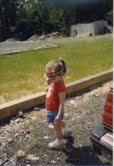Better assessment often depends on our own powers of observation: people don't see what they're not looking for, so if you're not looking for a child's ability to make meaningful connections, you'll miss it. Three stories to illustrate my point.
1. The Napkin
The first classroom I ever worked in was a 3-year-old room. One day at the easel, we teachers had put out bits of different colored tissue paper for the kids to stick to their paintings. There was one boy who was very excited to try it, but by the time he got a chance to paint, the tissue paper had been used up by others. His reaction was to stop and look around. He went over to the sink, where we kept the supply of cups and napkins for snack. He grabbed a napkin off the top, tore it and wadded it up all over his painting.
2. The Teacup
The pitchers we use at snack have handles that slide off for easy cleaning. Some of the kids discovered they could take the handle off all by themselves. One boy took the handle and balanced it next to his snack cup. He called me over. "Look! A teacup!!"

3. The Rainstick
One girl in my class loves music. By now I've learned not to worry if I don't see her for five minutes after she comes into school: I know she's gone across the hall to visit, dance, and sing with our music specialist. So one day, she was playing with the periscope from our science center. She'd removed the two mirror pieces at each end, and was looking through it like a spyglass. She spied a pile of bits and bobs from the carpentry table where we were taking apart a computer; she put a few screws and things in the periscope, placed her hands at both ends, and turned to me as she rotated her new invention - "a rainstick. Listen, doesn't it sound like a rainstick?"
So why's that so smart?
When you learn something, you literally make a connection in your brain, a new neural pathway that wasn't there before. What the children did in these stories was make a connection in their brain that could be seen by anyone who was watching. The boy in the first story spoke Spanish as a first language, and it was difficult to assess his cognitive skills through language alone, since he was learning English as part of his first school experience. Yet clearly, he made the connection between what he wanted (little bits of paper on his painting) and something that often ended up torn and wadded up (napkins from snack), and solved the problem of having no tissue paper for himself.
Both of the children in my current class made a connection between something they've previously encountered (a teacup, a rainstick) and the materials at hand. These small moments are easy to dismiss, but these are the moments that reveal a child's thinking and learning. This is what they do naturally. If we're not looking for it, we don't see it.
I understand that on a large scale, it is difficult to assess children observationally. It is time and labor-intensive on the adults' part. But what kind of example are we for the children we care for, if our assessments are slapdash, our efforts minimal, our attention somewhere else? What message do we send? It is a message of value: your ideas are not worth investigating, we are only interested in the right answer to an arbitrary series of questions. And so children - who are always making connections - make the connection that value lies in a very superficial measure of their experience (like ignoring all the other kinds of smart). The smartest things I've seen are moments when a child thinks something through, figures something out, goes deep into the soup of their experience to ask, "where have I seen this before? how does it apply to what I'm doing now?"
I'll talk more about those questions another time, in relation to the "other" kinds of smart, since they're just as applicable. For now, I will leave you with a task: think of a time when you made a cognitive leap - when something 'clicked' and you understood something you didn't before. Then think about whether it was something you were tested on or not.
Feel free to share if you'd like.

No comments:
Post a Comment